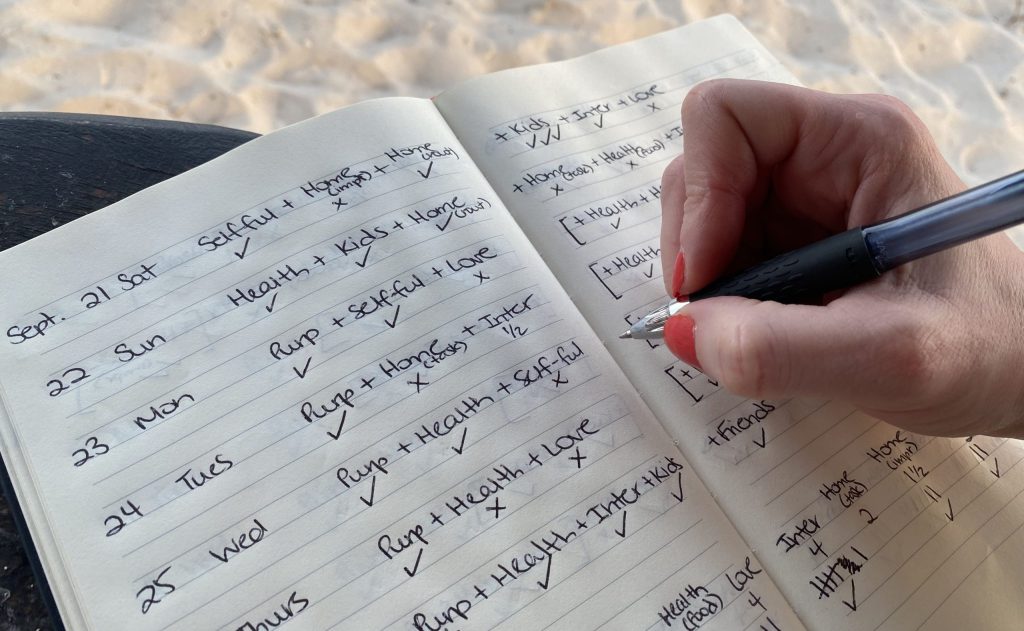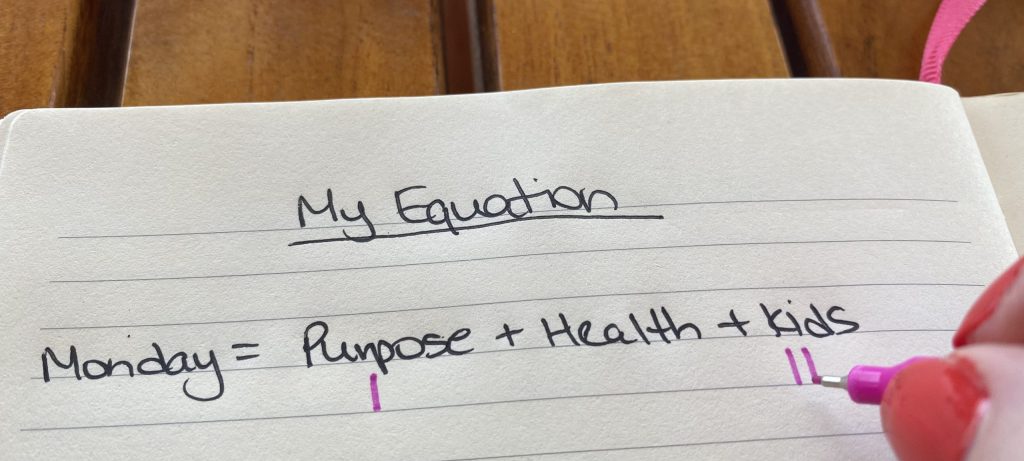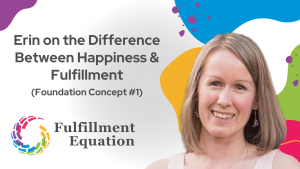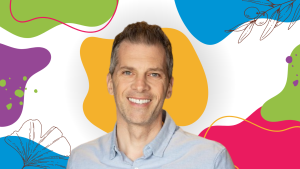
While the equation itself is important, what is even more crucial is the practice that you build around the equation. By “practice”, I mean the habits, rhythms and mindset that you use to approach living each and every day. This includes being deliberate about intention setting in the morning, finding flow and enjoyment while being guided by the equation throughout the day, and then engaging in reflection and gratitude before bed. These elements are what ultimately bring life to the equation. They transform the equation from something that might otherwise have the potential to be quite rigid into something dynamic that can grow, evolve and change over time.
The three daily elements of the practice:
Morning Intention Setting

We’ve all had experiences with the kinds of days I like to refer to as cyclone days and disappearing act days. These are not my favourite.
Cyclone days are the ones that completely spin away from you. It’s as if the train started moving before you even woke up and you’re propelled from one thing to the next without having a moment to lift your head up. It feels like you’re slipping off the back of a treadmill, running hard but you’re just a little bit late for everything and can’t quite get your feet firmly planted on the ground. You end up being a helpless piece of seaweed tossed about in the middle of a rough ocean. By the time you reach the end of the day, you’re exhausted, confused and just glad you made it to land without drowning. What makes cyclone days particularly characteristic is a sense at the end of the day that despite the busyness, you have nothing to show for it. You’re just standing there dazed after the whirlwind, surrounded by debris and mess and wondering what it was all for.

Disappearing act days share the same sense of emptiness at the end of the day, but without the frenetic pace. These are the kinds of days that just silently slip away from you. I find it’s more likely that these kinds of days happen on a weekend. The morning begins full of hope and promise because it’s the kind of day that isn’t dictated by your calendar, and then before you know it, like a magician’s dazzling act – “poof!” – the day is done and you’re left feeling unfulfilled, not really knowing how you spent your time and desperately wanting a do-over. To be clear, this isn’t necessarily about being unproductive. There is absolutely no need to meticulously plan, structure, schedule and execute each and every day. Not every day needs to be full of accomplishments. However, a relaxing day should be enjoyable and leave you feeling like your cup is just a little more full than it was when the day began. With disappearing act days, you don’t even feel that. You just feel the wastefulness of the time. What is missing is not the “productiveness”, but rather the intentionality and the choice.

The best antidote to protecting yourself from cyclone and disappearing act days is morning intention setting. This is a practice of being deliberate with your time. There are lots of resources and a heap of evidence that speak to the power of afformations and a morning routine of intention setting. Here is how to do it in less than five minutes using your fulfillment equation…
First, review your equation for the day to remind yourself of the areas in which you’d like to spend your time. For me, on a Monday as an example, my equation might say “Purpose + Health + Interests”. These are the cluster groupings I allocated to Mondays when I was building my equation. Once you’ve reminded yourself of your equation for the day, take a moment to connect these things with your “why”. By this I mean, remember why these things were important to you in the first place. The reason it’s helpful to connect to the “why” is to prevent the equation from feeling like a to-do list by taking a moment to remind ourselves of the reasons we actually want to do these things today. It’s a choice.
Next, review your calendar for the day. On a Monday, I might have meetings for work during the morning and early afternoon. I might also note that one of the kids has an activity in the evening. Now, I can look for opportunities to tentatively plan for when I might do the pieces of my equation. Perhaps I notice a break in the meetings just before lunchtime, so I can set the intention of doing a workout or a walk during that time in pursuit of the “Health” component. The “Purpose” component aligns with my work schedule for the day. Now I just need to accommodate the “Interests” piece. I know it will be a busy evening with dinner, the activity for one of the kids and bedtime, but I also know that I usually have an hour or so to play with after the kids have gone to bed. I set an intention to spend an hour on “Interests” around 8:30pm. I may have an idea of specifically what I want to do in the “Interests” and “Health” categories, but I always leave the opportunity for choice so that when it gets to the designated time, I can be flexible in exactly what I engage in depending on my energy level. The commitment is to the category, not the specific activity within it.
To finish, make a mental note of those key times so that they don’t pass by unnoticed. If a mental note isn’t enough, you can try setting a reminder or an alarm. In this case, I want to recognize at 11:30am that it is my opportunity for “health” and at 8:30pm that it is my opportunity for “interests”. It can be helpful to actually visualize yourself doing those things at those times. Picture in your mind what it looks like and when you do so, imagine a smile on your face while you’re doing it. Imagination and intention setting is powerful!

When it comes to traditional weekend days, there is often more flexibility. At the same time, there is generally more in my equation, so it becomes a bit of a balance. As an example, on a Saturday my equation might say “Self-fulfillment” + “Home (improvement)” + “Home (routine)” + “Kids” + “Interests” + “Spouse”. I start by reminding myself of my equation for the day and connecting to the larger “why”. This helps me remember why these things are important to me. Then, I consider if there is anything in the calendar that I will need to work around. If we have plans for friends to come over and I have “Friends” in my equation for Sunday, then I might think about what piece of my Saturday equation that I want to swap out for the next day. This is where the flexibility comes into play – I’m not trying to add more on top of the equation, rather I’m trying to balance it out over the course of the week. With a day like Saturday that is generally less scheduled, I also want to really consider my energy levels. If I know I have more energy in the morning, then I will want to set the intention to do the “Home (improvement)” piece earlier on as it is something I’m less likely to want to do as my energy starts to wane. If you live with other people, you may also want to consider the energy level of the house. My “Self-fulfillment” piece includes quiet things like meditation or reading a personal growth book. This is generally best in my house either first thing in the morning or late in the evening when the home is quieter. It would be difficult to feel fulfilled in this in the middle of the day when the energy level in the home is at its peak.
To finish, I make a mental note of my intention for the day: I’ll start with “Self-fulfillment” then do “Home (improvement)” and “Home (routine)” in the morning. After lunch, I will do “Interests” before our “Friends” come over. I deliberately move one-on-one time with “Kids” and “Spouse” to Sunday. I take a moment to visualize the day, knowing that I will need to be flexible and find flow, but that I also have a solid initial plan to get the day off to a good start.
This is the basic intention setting process for the fulfillment equation. However, there is more that can be incorporated into a morning intention routine, such as afformations, linking to goals, gratitude practice, etc. More on this later, but in the spirit of starting small, the morning intention setting for the equation is a great place to begin.
Finding Flow Throughout the Day

Now that our intentions have been set for the day and we have a clear path laid out, we want to find flow by being flexible, fluid, mindful and kind to ourselves. Ultimately, we are wanting to try to squeeze as much joy out of each activity as possible. Part of this joy-creation is in how we build the equation (thoughtfully selecting the pieces that “fill our cup” in life) and part of the joy-creation is in how we experience the “doing” of those pieces throughout the day.
Here are the most important things to focus on when attempting to find flow throughout the day:
- Be flexible with the specific activity – Another important aspect of flexibility is letting your heart guide you when it comes to the specific activity you engage in within a planned category. During morning intention setting, your brain may have ideas about what you would like to do in the time you’ve devoted to a cluster grouping. For example, if you have “Health” or “Interests” identified for the day, it might be thinking, “I’d like to go for a run” or “I’d like to do some painting”. One of the hardest things to master is being in touch with your heart when the time comes to engage in a category, and allowing that connection to guide your specific activity selection. The key is flexibility and choice. So, what does it look like to be in touch with your heart? It’s about noticing that small flutter of interest/excitement/curiousity about an activity. A feeling that is drawing you in. It’s about awareness in the moment of your energy level and respecting it. Finding a match between your energy level and a specific activity. It’s about not allowing your brain to weigh in too heavily on what it thinks you “should” be doing. The heart is much better at leading you to what you “want”. In our example, checking in with our heart may help us identify that we don’t have the energy level for a run today, so we’ll choose a walk instead. Conversely, there are days where you may feel great and so you’re going to harness that energy to go for a run even though you’d been originally thinking of doing a walk. Or perhaps you’d considered painting, but when the time arrives your heart would prefer to read a book. When designed well, our cluster grouping can have many different activity options and they are all equally valid. Think of it like a menu. In this analogy, morning intention setting would lead you to choose a certain category of food for lunch – say, Indian. But leading with your heart in the moment is like choosing a specific dish. When you chose Indian food in the morning, your brain may have been imagining butter chicken. However, hours later when you’re holding the menu, you may find yourself drawn to the curry special. Thinking of something in the morning doesn’t preclude you from picking something different off of the menu when the time comes. One choice is not inherently better than another. Being in tune with your heart in the moment allows you to be flexible with your activity selection because ultimately what you engage in is what will feed your soul.
Keeping these five things in mind will go a long way in helping you get the most out of the experience of your day. Yet even armed with these tactics, some days will just simply be more difficult and despite your best efforts, you will struggle to find flow. On these days, it is important to give yourself grace and remember that you can always reset throughout the day. If resetting still doesn’t work, let it go and embrace the simple gift that you will get a fresh start the next day.
Evening Reflection and Gratitude

The three components of the fulfillment equation practice are all equally important. They work together to provide balance – a beginning, a middle and an end. Like three legs on a stool, without one component, the practice can become wobbly. Each component plays a role in supporting the others. The morning intention setting goes a long way to setting you up for success throughout the day. Finding flow during the day can put you in the right headspace and give you ample substance for reflection and gratitude. And the evening reflection and gratitude reinforces the thoughtfulness of your morning intention setting and fills your heart in a way that gives you the fuel for the next day. Similar to intention setting, there is a lot of evidence for the power of a gratitude practice. Here is how to do it in less than five minutes using your fulfillment equation…
At the beginning of the week, create a copy of your weekly equation complete with what I call the “weekly balance” at the bottom. The weekly balance is the list of all of your clusters with the amount of ideal blocks that you’ve associated to each one. I’ve found it best to begin my week on Monday rather than Sunday as I tend to work a traditional work week so there is usually a fair amount of flexing on the weekend days, therefore I like to keep those days together in my tracking. Choose where to start your week in a way that works best for you – if your days off tend to be Mondays and Tuesdays, then you may want to start your tracking weekly on Wednesdays. In any case, I find it helpful to leave the most flexible days to the end of my tracking period because it gives me a chance to make decisions with my time based on how things have played out in the less flexible days. In terms of making the weekly tracking sheet, you could easily make photocopies of your original fulfillment equation page and simply write a new date at the top. I prefer to use a journal to handwrite my equation at the beginning of each week because it gives me an opportunity to reconnect with my intentions and visualize my plan.
Each evening before bed, start with some deep breaths to calm your body and mind so that you are in a good headspace for reflection and gratitude. Then review your equation for the day. For each cluster built into your day, make a mark under your daily equation if you managed to spend time engaged in that activity. For example, if your equation for the day was Purpose + Health + Kids and you went to work and spent time reading to your kids before bed, then put a vertical line (tally notch) or a checkmark under Purpose and Kids. If you didn’t do anything in your Health cluster, then leave it blank. Sometimes you may find you did more of an activity than you would consider a regular tally in your equation. For example, maybe you read to your kids before bed and also walked with them to school that morning. Two separate, but meaningful, opportunities to connect. In this case, make two tallies or checkmarks. This isn’t about overachieving, but rather it will provide you with helpful information later in the week when you may want to make tweaks to your intentions on a particular day in order to balance out your equation. More on that later.

Often, during reflection, you may find that you contributed quality time to a cluster that wasn’t in your equation for the day. This can happen when you make a deliberate choice to trade off something today for something another day, like our example in the morning intention setting about swapping out “Friends” between Saturday and Sunday. It can also happen because an opportunity spontaneously arose that you jumped on. Perhaps you and your partner decided last-minute to meet up for lunch on a day where you normally don’t have the time and space for a meaningful connection in a quiet environment. You hadn’t been deliberate in carving out time for one another that day, but the stars aligned and you took advantage of the opportunity. In these cases, write down the cluster name in parentheses at the end of your daily equation and mark it with a tally. This information will also help you later on in flexing your week.

Now that we get the mechanics of daily tracking, let’s lift back up out of the analytics to focus on the most important part – your mindset. Mindset is really critical for the tracking portion of the evening reflection and gratitude. The tracking is intended to serve two main purposes. Firstly, it is an opportunity to feel good about the things you DID do. It is not a place to feel badly about the things you DIDN’T do. It is not about achievement. You are only looking at the positive. Pretend that the day is a blank slate and if you didn’t do ANYTHING then that is your baseline. Everything on top of that is a bonus. Secondly, the tracking is for information and decision-making purposes. This is where it is important to adopt the mindset of a scientist. You are experimenting, learning, growing and adapting. There is only space for curiousity and problem solving. There is no space for judgment and berating. Give yourself grace and step outside of yourself to view the day as an observer.
Once you’ve completed the tracking, return back into your emotions and your heart for the gratitude practice. Review the day in your mind, looking for moments and memories that stir your heart. I think of them as little nuggets of joy. Perhaps it was a moment of quiet flow that you found at work. Perhaps it was the laugh of a family member at the dinner table. Perhaps it was the feel of the sunshine on your face as you walked to the corner store. These nuggets of joy are not often extraordinary; they are regular occurrences. They are the heart of everyday living. I like to choose one beautiful moment from each day and write it in my journal. The gratitude practice can fill us with love and help us feel thankful for what we have. Take a moment to reflect on and feel proud about any success you had in the day in spending time doing the things you had planned in your equation. Let the rest go. You can also reflect on the gift of the time in the day and thank yourself for the energy you brought to it. With the evening gratitude practice, you may find that over time it replicates itself into smaller gratitude moments throughout the day. For example, because I know I am going to choose a beautiful moment at the end of my day to write in my journal, I often find myself tuned in to noticing those beautiful moments as they happen during the day. There are a lot of great resources out there on the importance of gratitude and building a gratitude practice. For the purpose of the fulfillment equation, it is an essential component because it helps to keep us out of “achievement-oriented, have-to-do” mode and grounds us firmly in the “deliberate, steady, glass half full, want-to-do” mindset that is so critical for us to thrive.
Read Next Article: Step 4 – Flexing Your Week




